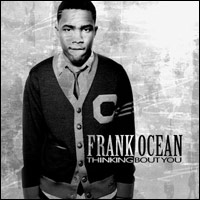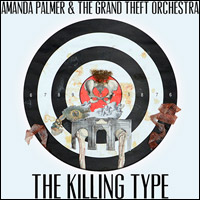Favorite Albums
Ah, the end of the year lists, where young writers’ thoughts turn to panic. (What the heck did I listen to this year?) It’s also the time when you realize there were a ton of records you simply didn’t get to or that got benched as newer things came out. This isn’t a definitive list of the greatest records of the year, but a tally of the records that got the most play on my stereo. It could have easily been a much longer, but this year I decided to go all P90X and keep it tight and lean. Now, without further adieu, let’s get it on!

The Idler Wheel...
Epic
Fiona Apple occupies a rare place in today’s music. For most artists taking a seven-year break would be unheard of. The fact that she’s only released four albums in 16 years is equally mind-boggling. But Apple retains the type of loyalty that some of her former contemporaries, say Paula Cole, lack. The Idler Wheel... shows that the faith is well-placed. Working with her drummer Charley Drayton as co-producer, the album is a lean affair of only piano, drums and other manners of percussion. But it sounds fuller and more robust than that description would suggest, with Apple bending and pushing her voice to unexpected places. Lyrically, she’s still trafficking in topics that are both intimate and expansive, a challenging journey through her mind.

Master of My Make-Believe
Atlantic/Downtown
With Master of My Make-Believe, Santigold has kept her sonic palate wide open. So there are new wave moments sitting next to dancehall-influenced tunes with a smear of Moombahton and some Kate Bush-ish moments. It’s the type of record that in its parts is wildly all over the place, but as a whole is amazingly coherent. It’s also the type of record where every song sounds like a hit without getting too desperate about it. Simply put, Master of My Make-Believe is a fantastic follow-up and deserves to be the soundtrack for the next two summers.

The Haunted Man
Capitol
Listening to The Haunted Man, it’s hard to shake the thought that if Natasha Khan had been around in the ’90s, she would have been huge. The album channels a gothic sensibility that seems to suggest she’s a child of Siouxsie Sioux, as well as Tori Amos and Dead Can Dance. But the record is a more than a Frankenstein monster of influences. Where Khan succeeds is that she makes it seem brand new. The Haunted Man is more electronically based and less grand and sweeping than her previous record, Two Suns, but is no less of an immersive experience. It’s the type of record you can get embarrassingly lost in.

Not Your Kind of People
Stunvolume
Garbage was always an interesting beast if for no other reason than there was always a bunch of moving parts. The blend of rock, electronic and pop songs made for weird juxtapositions, but great hooks held it all together. Thankfully, those same qualities are present on Not Your Kind of People, Garbage’s return after a seven-year hiatus. Shirley Manson lyrically balances between dark and light, tough as nails and vulnerable as china, making each moment believable. She connects in a way that didn’t always come across on Garbage’s last record, Bleed Like Me. Musically, the boys in the band have her back at every step. It’s the type of record that succeeds at such a high level, it makes revisiting the back catalog inevitable. It also shows the wisdom of not bowing to any current trend. Even with seven years off, Garbage has stayed Garbage.

MDNA
Interscope
Madonna may be past the days of her pure-pop perfection, but still, when she’s on she’s on. MDNA continues her return to the dancefloor after what could be called her “mature trilogy” (Ray of Light, Music, and American Life). Here, she is reunited with longtime collaborator William Orbit, as well as producers Martin Solveig and Benny Benassi. Of course, there is also appearances by MIA and Nikki Minaj, and there is a dubstep section. The result may not a classic outing, but it is a very good showing. There are plenty of solid jams and even some pretty great songs in club drag. The guest appearances are probably unnecessary and Madonna slides in some big wink self-referential moments, but it is more endearing than off-putting. In other words, there may be some empty calories, but it’s still delicious.

Landing on a Hundred
Vibration Vineyard
If you’ve gone a decade without a follow-up to your debut album, it’s fair to assume that it’s a wrap. So, Cody ChesnuTT’s return to the spotlight with Landing on a Hundred is a surprise of the best kind. Gone are the Guided By Voices–like song fragments and lo-fi approach of his double-album debut, The Headphone Masterpiece. Instead, Landing is a robust, full-tilt, high-definition soul explosion. Mixing the swagger of a revival tent with plainspoken lyrics, ChessnuTT makes his throwback tendencies sound modern and vital. Here’s hoping it won’t be another decade before his next record. But if it is, it seems like ChessnuTT will be okay.

RAP Music
Williams Street
El-P
Cancer4Cure
Fat Possum
While vastly different, these two albums seem to work as companion pieces. RAP Music is the unlikely collaboration of Southern emcee Killer Mike and New York underground king EL-P on production. On paper, the two have nothing in common, but if you’ve been following Killer Mike, you know he has a tough-minded approach not unlike that of his producer. Still, EL-P tailored his style to suit the album, leaving his industrial storm for his own record. While the soulful backdrops sound natural for Mike, it feels almost revolutionary from EL-P. Killer Mike is more than up to the challenge, channeling classic Ice Cube as well as his own inimitable style.
While EL-P’s rep seems frozen in amber as the “independent as fuck,” paranoid, industrial noise–loving, claustrophobic obtuse emcee, he’s been much more than that for years. Cancer4Cure is as challenging as anything in his back catalog, but this go-around EL-P seems more determined to make his message clear. He’s also not afraid to let the songs breath, stepping back and letting the music do the work instead of cramming every second with vocals. One the best comparisons would be the evolution of the Bomb Squad where the “noise” evolved over the course of a few albums. EL-P has never made the same record twice and this is as exciting and vital as anything he’s ever done.

Coexist
XL
The XX are an unlikely success story. The fact that the band’s minimalist, elegant drone captured a relatively mass audience and critical acclaim seems absurd. Maybe it’s because in a world of in-your-face production and overworked performances, the restrained approach struck a nerve. Coexist goes further down that path. Each element exists in a very specific space. There’s no wall or wash of sound, but a lot of air and space. Jamie XX’s production does play a big part, but it’s far subtler than he could have gone. The band is more direct and confident than on its debut. It may not be the big stylistic or sonic change that some fans may want, but like their music, it’s not the big gestures but the small details that matter. And as Coexist shows, those details reveal volumes.

Swing Lo Magellan
Domino
After becoming both the critics and the people’s champs with ’09s Bitte Orca, the Dirty Projectors had carte blanche to go in nearly any direction. And with a catalog that includes a concept record about Don Henley and a recreation of Black Flag’s seminal Rise Above from memory, the band could have truly landed anywhere. Or they could have buckled under the pressure. On Swing Lo Magellan, they doubled-down on the elements that make them great: the intertwining female harmonies, the siren-like lead vocals of Dave Longstreth, and music that dips into R&B, folk, hip-hop, orchestral pop and West African guitar stylings. Clever without being self-conscious, challenging without being obtuse, Swing Lo Magellan further shows that Dirty Projectors are worthy of the hype.

Theatre Is Evil
8 Ft.
To paraphrase former President George W, after a number of years navigating her career in various unorthodox ways, Amanda Palmer has earned some capitol and by god is she going to spend it. If you were a longtime fan or longtime detractor, there were probably some preconceived notion of what Theatre Is Evil would bring to the table. Whelp, Palmer zigged where you thought she would zag. Working with her band, The Grand Theft Orchestra, the album embraces new wave, synth-pop and glam in unexpected ways. While there are piano-driven songs, Palmer took advantage of all the new colors in her sonic crayon box. The results are at turns exhilarating, heartbreaking, humorous, earnest and blush-worthy dirty. Simply put, the ambition paid off.

“My Love Is Real”
Merge
“My Love Is Real,” the leadoff single from indie supergroup Divine Fits—Brit Daniel (Spoon) on guitar and vocals, Dan Boeckner (Wolf Parade) also on guitar and vocals, and Sam Brown (New Bomb Turks) on drums—is the Trojan horse of the record. The synth-pop number seems to simultaneously give a big middle finger and a heads up that things might get weird. Come for the ’80s influence, stay for the sardonic lyrical blow-off.

“The Sun and Moon”
Saddle Creek
Cursive never lacks for ambition. Their current album is a concept record about twin brothers, Cassius and Pollock, who were separated at birth, and who represent the split between good and evil as two parts of one whole. This insistent, mathematically hooky song is the standout track that also serves as the Cliff Notes version of the record, but even if you don’t know the story, it stands on its own two feet.

“Cruel Intentions”
429
“Cruel Intentions” is the outlier on Soul Asylum’s very solid comeback album. It’s a soulful jazzy number on a record steeped in the traditional Soul Asylum fare, but that almost makes it better in that it shows an unexpected versatility. It really shouldn’t work, but sweet fancy Moses it does.

“Disparate Youth”
Atlantic
At times it seems like Santigold looks at her song titles as thesis statements. Take, for example, “Disparate Youth,” from her sophomore album, Master of My Make-Believe. With so many songs that seemingly only exist to get to the chorus, this track almost has an anti-chorus. The spastic guitar bursts that punctuate the song act as more of a hook than the actual chorus, and at no point is the titular phrase uttered. The song is about disparate youth, but it’s also part instructional speech, part motivational anthem, while the backdrop of Santigold’s post-dub and synth punk-funk styling is like getting a vitamin-enriched Klondike bar.

“Born To Die (PDP 13 Remix)”
Interscope
Maybe it was just out of spite for bloggers losing their minds, but “Born To Die ” stayed in heavy rotation for most of the year. I suspect that is why Damon Albarn gave the track the remix treatment—only the second remix he’s done in his career. He gives the original orchestral drama a dubbed out re-rub that grooves far harder than it has any right to.

“Packt Like Sardines”
Interscope
Even though Blueprint had brought his singing to the forefront on the excellent Adventures in Counter-Culture, this radical recasting of Radiohead’s Amnesiac opener as boom-bap soul song was the type of gamble that paid off.

“Somebody That I Used to Know”
Samples & Seconds/Republic
In this age of fractured listenership, it’s rare that a song crosses over. But “Somebody I Used To Know” seemed to be everywhere. The dinky xylophone, muted keyboards, the low-tempo shuffle—nothing about it screamed “hit.” But as the cold-blooded retelling about the disintegration of a relationship unfurls, it hits the universal chord of love gone badly. Like an update of Human League’s “Don’t You Want Me,” complete with a guest spot by Kimbra for the rebuttal, it was a song equally popular with the Glee masses as scuffed tennis–shoed indie dudes.

“Thinking About You”
Def Jam
Modern R&B can be a mind-numbing and embarrassing experience. Too often it’s nothing but single entendre songs about carnal engineering. So it’s shocking one of the boldest challengers to that status quo is possibly one of the most low-key songs on radio. Equal measures serious and sarcastic, playful and wistful, Ocean is less the “superman lover” and more the average dude trying to figure it out.

“Mercy”
Def Jam
“Mercy” is exactly the type of song that people who hate Kanye will point out to show why they hate Kanye. For the rest of us, it’s an absurdly catchy piece of doggerel. Sure it’s not about anything in particular, but this posse cut is a rewindable piece of non-sequiter theatre. And there’s something hilariously dickish about Kanye making the only change up in the record happen during his verse.

“The Killing Type”
8 Ft.
On an album full of great songs, “The Killing Type” is a standout. Kicking off possibly one of the best three-song run of any record this year, it the perfect balance of performance, production and dynamics that makes me freak out every time I hear it. But beyond the visceral reaction, it’s just a perfectly constructed song that’s as deceptive as a rock in a snowball.
Blur, Blur 21: The Box (Parlophone)
Massive Attack, Blue Lines: 2012 Remix/Remaster (EMI)
Feedtime, The Aberrant Years (Sub Pop)
DJ Shadow, Reconstructed (Quantum/Hip-O)
Marvin Gaye, Trouble Man: 40th Anniversary Expanded Edition (Hip-O)
Rage Against the Machine, XX (20th Anniversary Edition) (Legacy)
Smashing Pumpkins, Mellon Collie and the Infinite Sadness (Virgin)
The Weeknd, Trilogy (Universal)
Paul Simon, Graceland: 25th Anniversary (Legacy)
Codeine, When I See the Sun (Numero Group)
Sugar, Copper Blue/Beaster and File Under: Easy Listening (Merge)
Spain, The Blue Moods of Spain, She Haunts My Dreams, and I Believe (Omnivore)
